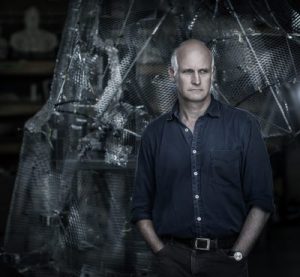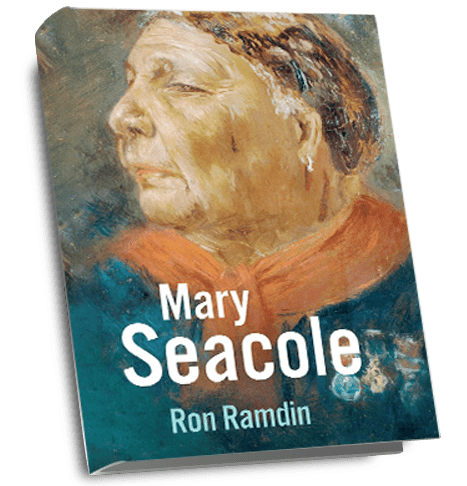Mary Seacole Statue
The unveiling followed a 12 year campaign for funding by the Mary Seacole Memorial Statue Appeal, raising over half a million pounds with much coming through small donations from schools, nurses and army units, emphasising the popularity of the appeal across a wide spectrum of British society. In November 2015, the Chancellor of the Exchequer announced the donation of £240,000 of LIBOR banking fines to pay for the installation.

The artist – Martin Jennings
The statue was conceived and produced by Martin Jennings FRBS. His celebrated body of work includes larger than life-size figures of the poets Sir John Betjeman in St Pancras Station and Philip Larkin in Hull – highly acclaimed works that are testimony to his career as a world-renowned artist.
Martin Jennings writes:
“…The sculpture represents her marching defiantly forward into an oncoming wind, as if confronting head-on some of the personal resistance she had constantly to battle…”
Mary Seacole was an intrepid, determined, dynamic figure, always on the go, either physically in terms of endless journeying locally or between continents, or intellectually in terms of her efforts to find remedies for the sick. The sculpture represents her marching defiantly forward into an oncoming wind, as if confronting head-on some of the personal resistance she had constantly to battle. She carries her bag of medications and poultices towards the scene of battle. Though she would normally have worn a bonnet or straw hat and liked to sport ribbons and bright colours, these have been pared away to leave her marching bareheaded into the fray.
Behind the figure of Mary stands a vertical bronze disc, cast from an image of the earth on or near the site where she established the British Hotel in the Crimea. The disc performs both practical and symbolic functions.
The disc works symbolically in a number of ways. Not only does its startling verticality and comparative blankness communicate to the viewer that this is clearly a sculpture from our own time rather than a mere pastiche of 19th century statuary, it also works to put Mary Seacole in the context of her time and place. Her autobiography communicates a powerful sense of place, whether in the Panamanian jungle or the fly-blown heat of the Crimean summer. Literally I wish to bring that place to viewers of the sculpture. The disc can also be seen as a model of the earth, over whose surface she constantly travelled, during a period when pioneering travel was in the ascendancy. As a tiny fragment of a foreign land it also hints at the pathetic nature of the dusty scraps of earth over which, in an imperialist age, so much blood was spilt.
The disc points up the essential emotional narrative of Mary Seacole’s life. In a key passage in her autobiography she describes waiting in the hallway of the Secretary at War to be accepted as an official member of the nursing team being sent to the Crimea. When she realises that she has been stonewalled solely on account of her ethnic origin, she communicates a personal pain that can be shared by anyone who has ever been rejected merely for who they are rather than for any lack of merit. This stonewalling, which is at the heart of the racial intolerance experienced by Mary Seacole 150 years ago and indeed of all racial intolerance, is something which finds physical form in the monument. Confronting a stone wall, Mary turns her back and marches defiantly towards her destiny and into history.
Both the figure and the disc are cast in bronze. The disc is patinated a paler colour than the figure in order to enhance the shadow thrown by the illumination of the figure. The plinth is of Cumbrian black slate bordered by Portland stone around its edge. The full height of the monument, including its plinth, is 4.9m. The figure of Mary weights 1.5 tons and the disc over 5 tons. The casting was produced by Pangolin Editions of Gloucestershire.
The Mary Seacole Statue Unveiling Video
The statue was unveiled by Baroness Floella Benjamin OBE, Deputy Lieutenant of Greater London. More than 300 guests who attended the unveiling were addressed by a number of high-profile speakers – including Sir Hugh Taylor, Chairman, Guy’s and St Thomas’ NHS Foundation Trust; Lord Soley, Chairman, Mary Seacole Memorial Statue Appeal; and Diedre Mills, Acting Jamaican High Commissioner who marked the contribution Mary Seacole and other black and minority ethnic people have made to Britain throughout history.
The unveiling of the statue came after 12 years of campaigning by the Mary Seacole Memorial Statue Appeal to raise the necessary funds for the iconic bronze statue created by sculptor Martin Jennings. More than £500,000 was initially raised through donations from thousands of individual supporters as well as a number of larger donors. In November 2015 Chancellor George Osborne announced that £240,000 of LIBOR banking fines would be donated to the appeal to pay for the installation.
Lord Clive Soley, Chair of the Mary Seacole Memorial Statue Appeal, commented:
“After 12 years of campaigning, we are proud to finally grant Mary Seacole the acknowledgement she deserves for her pioneering work and selfless support of British soldiers and sailors.
We are delighted to be unveiling the statue today at St Thomas’ Hospital and would like to thank everyone who has supported the appeal, including the many nurses, schools and army units who were inspired to donate funds for the statue. We are also very grateful to the Chancellor who made this possible with a donation of £240,000 for the installation of the statue.
The statue will be a fantastic new landmark on the South Bank providing much needed recognition of the contribution which black and minority ethnic people have made throughout British history, and a celebration of the UK’s diversity.”
Sir Hugh Taylor, Chairman, Guy’s and St Thomas’ NHS Foundation Trust, commented:
“I am delighted that we are hosting the statue in memory of Mary Seacole in the gardens of St Thomas’ Hospital.
This will be a fitting tribute to a woman who was a pioneer for the generations of nurses and other staff from black and minority ethnic backgrounds who have served the NHS so well over the years.
Mary Seacole is a positive role model for the current generation of nurses and other healthcare professionals, speaking to the diversity of our local population, our patients and the staff who work here.
I hope that the presence of a statue of this iconic figure in our gardens will serve as an inspiration to our staff as they strive to provide high quality care to our patients.”
Lance Corporal Johnson Gideon Beharry VC, commented:
“I have been a supporter of the Appeal from the start because of the strong connections that I feel between myself and Mary Seacole. She is from Jamaica, I am from Grenada so we share a Caribbean background, but more than that, I am also of Scottish and African descent which means that we have the same heritage.
Mary went to the Crimea independently and set up a field hospital. I received the Victoria Cross, a medal first awarded in the Crimean War and is to this day struck from the metal of a Russian gun, captured at the Siege of Sevastopol.
Already very strong connections, but I have even more reason to be involved given that I know what it is like to be injured in action and to be cared for on the battlefield. Mary has been criticised for not being a ‘proper nurse’ but Caribbean people traditionally have a grounding in herbal medicines, they do work.
As a soldier, I know that Mary is without doubt a popular figure and we would class her as one of us, no different from anyone else involved in the conflict. I still remember the nurses who looked after me, I can never thank them enough. As soldiers we would worship someone who offered the care that Mary gave to the soldiers in her care. Nothing has changed in war between then and now, only the technology is new.
I came to England from the Caribbean and became the face of the British Army. Mary made the same journey and was voted the Greatest Black Briton — I was also on that list. I feel I am following her along a pathway and will continue to support her legacy.”
Speakers on the day:
- Sir Hugh Taylor, Chairman, Guy’s and St Thomas’ NHS Foundation Trust
- Lord Soley, Chairman, Mary Seacole Memorial Statue Appeal
- Baroness Benjamin OBE, Deputy Lieutenant of Greater London
- Martin Jennings FRBS, Sculptor
- Diedre Mills, Deputy (Acting High) Commissioner, Jamaican High Commission, London
- Colonel Marie Richter, Commanding Officer 256 (City of London) Field Hospital
- Dame Elizabeth Anionwu CBE FRCN, Vice Chairman, Mary Seacole Memorial Statue
Appeal
Notable Guests on the day:
- The Rt Hon. The Baroness Scotland of Asthal QC
- Lance Corporal Johnson Gideon Beharry VC
- Simon Stevens, Chief Executive, NHS England
- Jane Cummings, Chief Nursing Officer, NHS England
- Len McCluskey, General Secretary, Unite
- Diane Abbott MP Hackney North and Stoke Newington
- Dawn Butler MP Brent Central
- Helen Hayes MP Dulwich and West Norwood
- Fiona Mactaggart MP Slough
- Malorie Blackman, Author
- Edward Fox, Actor
- Gill Prager, President, Nightingale Fellowship
- Professor Elizabeth Robb OBC, Chief Executive, Florence Nightingale Foundation
- Sue Sheridan, Chair of Trustees, Florence Nightingale Museum
The Mary Seacole Memorial Statue Appeal video
Memorial Plaque
A plaque commemorating healthcare workers who have put themselves at risk to care for people caught up in conflict and natural disasters was unveiled by Sir Hugh Taylor, Chair of Guy’s and St Thomas’ NHS Foundation Trust, on Friday 8th December.
The plaque reads:
“This plaque is to honour those healthcare workers who have dedicated themselves to aiding others in times of war, conflict and catastrophe throughout history.”
The unveiling ceremony took place at St Thomas’ Hospital, where guests were welcomed by Trevor Sterling, Chair of the Mary Seacole Trust, and by Sir Hugh Taylor. Colonel Marie Richter, Commanding Officer 256 Field Hospital, spoke in praise of the selflessness and courage of healthcare professionals in difficult and dangerous situations. Deputy High Commissioner for Jamaica Mrs Angella Rose-Howell’s address celebrated Mary’s grounding in nursing in Jamaica.
Sir Hugh performed the unveiling ceremony on a bright but chilly afternoon in the hospital’s Millennium Gardens.
Wreaths were laid by representatives of the Chelsea Pensioners and Dawn Hill, Trustee and President of the Mary Seacole Trust. A guard of honour was formed by the 256 (City of London) Field Hospital and the Army Cadet Force of Greater London.
The beautiful plaque was created by Chichester Stoneworks Ltd.
We would urge members of the public to visit the plaque, created by Chichester Stoneworks Ltd, which is located in the Millennium Gardens at St Thomas’ Hospital.



